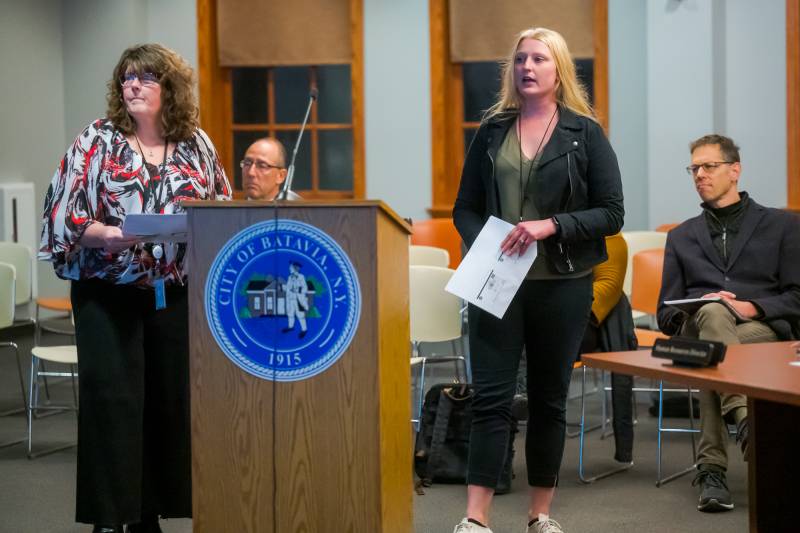
Photo by Howard Owens.
If you were asked to name the number one cause of lung cancer among non-smokers, it may surprise you that the answer is not second hand smoke, often portrayed as perhaps the most dangerous substance to lungs for those exposed to the fumes of others.
The top cause of lung cancer is actually radon for nonsmokers, and overall is the second leading cause of lung cancer for the general population, Public Health Educator Sherri Bensley of Genesee and Orleans Health Department says.
Not often something discussed at the dinner table or thought about in the home, radon is responsible for about 21,000 lung cancer deaths every year, according to GO Health statistics.
Although the topic up to now has been a quiet one, Bensley and Environmental Health Specialist Allysa Pascoe have been taking a presentation on the road — including to City Council this week — to review the basics of radon and remind folks about the importance of what to keep in mind with this radioactive gas.
"The GO Health Departments would like residents to know that radon is the leading environmental cause of any cancer and it is the second leading cause of lung cancer, after smoking," Bensley said to The Batavian. "Radon can enter a home through cracks in the foundation, cracks in basement walls, holes, joints, dirt floors, sump pump holes, suspended floors and in the well-water supply.
“Any home (new or old), that has contact to the ground has the potential for radon to enter the home," she said. "Testing your home is the only way to know if high levels are present and corrective action is needed.”
Tests were conducted in Genesee County, and Stafford was found to be the area with the highest levels of radon in the lowest living area of the home, which was the basement.
Levels were at greater than 10 pCi/L (that is picocuries per liter), with several areas reaching greater than 4 and less than 10, including Byron, Bergen, Batavia, Le Roy, Darien, Bethany, Pavilion and Pembroke. Towns and villages of Alabama, Oakfield, Elba and Alexander had the lowest levels of less than 4.
When testing was conducted on first floors in the county, Stafford remained at 10, and was joined by Darien; whereas the 4 to 10 levels were only in Batavia, Bethany and Le Roy and remaining municipalities had levels of 4 or lower.
The health department distributed radon test kits from Jan. 17 of this year to June 30, with 37 elevated readings out of 174 total kits, Bensley said. From July 1 to now, there were 73 more kits distributed, and 23 elevated readings.
GO Health has been able to do this through a New York State Indoor Radon Grants Program meant to increase public awareness about th risks and health hazards of radon exposure. It’s a sneaky inert gas that’s colorless, odorless and tasteless that cannot be detected by one’s senses.
Exposure to radon can damage tissue and may cause lung cancer since it is a carcinogen. It also can be found anywhere, since it’s produced by the decay of uranium in soil, rock and water.
So now that you may be sufficiently scared, or at least concerned, what to do about it?
“With funding provided by the New York State Department of Health, the Genesee County Health Department has free radon test kits available to residents of Genesee County,” Bensley said. “If someone finds that their home has a high level of radon, we would recommend that they hire a certified mitigator to install a radon mitigation system to reduce radon levels in their home.”
The department has also proposed that all new homes be built with radon-reducing features, which would be more cost effective, eliminate potential exposure and is currently a requirement in 11 other states, she said.
The test is made of charcoal, and it is uncapped for at least 12 hours during the test period. It will be placed on the lowest level of the home that is frequently occupied. Once radon is detected, certification is not required in New York State, but is recommended, she said.
She also recommends that, when pursuing mitigation, obtain several estimates, check references, and obtain a guarantee that the mitigator will reduce the radon to below 4.0 pCi/L. Go here for more information about mitigators.
For more information about radon or obtaining a test, email Allysa.Pascoe@co.genesee.ny.us or Sherri.Bensley@co.genesee.ny.us or call 585-344-2580, Ext. 5528.
